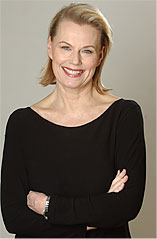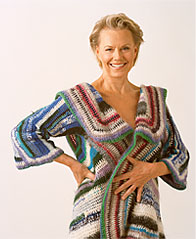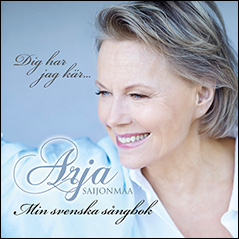


Hej!
Varmt välkommen till min hemsida. Här kan du få veta mer om mig, mitt arbete och mina ambitioner förr och nu. Du får även veta vad jag ser som viktigt i mitt liv just nu och vad jag, du och alla andra, kan göra för att skapa en bättre värld för oss alla. Som artist vill jag bidra till att vi bygger broar mellan människor och mellan olika kulturer. Ha ett trevligt besök!
Med vänliga hälsningar
Arja Saijonmaa
Arja Saijonmaa är född i regementsstaden Sankt Michel (Mikkeli), som ligger i det sjörika sydöstra Finland.
Hon är uppvuxen i en finskspråkig miljö och började redan som femåring att spela piano.
När hon var 11 år framträdde hon som solist med en av Mozarts pianokonserter tillsammans med Mikkelis symfoniorkester.
Efter studenten fick Arja ett Fulbrightstipendium för ett års studier vid Stephens College Columbia, Missouri, USA. Där tog hon en AA (Associate in Arts) innan hon återvände till Finland och började på Helsingfors Universitet. Där studerande hon drama, litteratur och musikvetenskap och tog senare en fil. kand.(Master of Arts) i dessa ämnen.
Parallellt med universitetsstudierna gick hon solistlinjen för piano vid Sibelius-Akademin i Helsingfors.
Arja har dessutom gått på filmskolan på Konsthögskolan i Helsingfors. Arja var även aktiv inom studentteatern i Helsingfors(66-70). Där började hon med praktiskt produktionsarbete och fick sedan roller i olika uppsättningar, bl.a. i politiska kabaréer. Det var i dessa kabaréer som Arja började sjunga på allvar. -Det var mycket blod, svett och tårar, säger Arja. Men det var det här praktiska teaterarbetet som blev min skolning i scenkonsten. Till slut blev Arja studentteaterns chef och konstnärliga ledare i två år.
Hon satsade på pjäser av Bertold Brecht och annan politiskt medveten teater.
På hösten 1970 kom den grekiske kompositören Mikis Theodorakis till studentteatern och träffade Arja. Det ledde till ett samarbete och internationella turnéer.
Arja Saijonmaa har, förutom sina konserter, också framträtt med krogshower och föreställningar i kabaréstil, t.ex. på krogscenen Börsen (Hamburger Börs) i Stockholm och på många andra ställen i världen.
I samarbete med bl.a. teaterregissören Vivica Bandler har hon genomfört ett flertal ”One Women Shows” med olika teman. Efter att Arja en tid sjungit mot grekiska och chilenska diktaturer ville hon återvända sin egen finska kultur och hon satte upp en ”One Women Show” i Sverige med den finska tangon som tema samt modern poesi och texter av kvinnor.
Arja var den första som förde in den finska tangon till Sverige. - Det var första gången svenskarna fick ett nyckelhål in till den finska folksjälen, säger Arja om föreställningen.
En sång från föreställningen, "Ljuvliga Ungdom" blev mycket populär och finns nu i den svenska visboken. En annan föreställning på Hamburger Börs i samma stil byggde på ett italienskt musikaliskt material,”O Vita Mia”. Arja uppträdde även med två föreställningar på engelska i New York: ”Scandinavian Love Story” på Broadway och ”Brecht´s and Theodorakis´Songs” på jazzstället Village Gate.
I Broadwayföreställningen blev Märta Tikkanens ”Århundradets kärlekssaga” introducerad på scenen. Arja Saijonmaa har haft huvudrollen i flera musikaler. Några har skrivits direkt för henne.
I ”Kavallerijungfrun” spelade Arja en kvinna som förklär sig till kavallerist för att få vara nära den man hon älskar. Den bygger på en verklig historia om den ryske författaren Pusjkins älskarinna. Föreställningen producerades av Kungliga Operan i Stockholm och framfördes på Södra Teatern.
Föreställningen sändes också i TV. Arja spelade huvudrollen som Zarah Leander i musikalen ”A Star Fell”, speciellt skriven för Arja, som handlade om den svenska artisten och den stora divan Zarah Leanders liv. Föreställningen framfördes i Säffle, som var Zarah Leanders födelsestad, och var ett samarbete med Värmlandsoperan. Arja har samarbetat med den finskamerikanska koreografen Carolyn Carlson. Hon var sångerska och skådespelare i Carlsons moderna dansgrupp, ”Groupe Recherche du Theatre de L´Opera de Paris.” De gjorde en föreställning på Operan i Paris, som sedan gick på turné i Frankrike, och sedan vidare till 14 länder i Asien.
Turnén pågick ett halvår och hade stöd av det Franska Kulturministeriet.
Arja Saijonmaa betraktar Mikis Theodorakis som sin viktigaste mentor och de har nu samarbetat i över 30 år. Mikis Theodorakis, bl.a. känd för att ha gjort musiken till filmen ”Zorba”, var motståndare till den dåvarande militärdiktaturen i Grekland och han tvingades då leva i exil. Arja fick sitt internationella genombrott som en kraftfull uttolkare av Mikis Theodorakis sånger vid en världsturné 1970-72. När Arja återvände till Norden efter sin världsturné ville hon introducera Mikis Thedorakis även för den nordiska publiken.
Hon fick några av nordens bästa poeter att ta sig an Mikis texter. Arja kunde sedan göra Theodorakis musik och texter, i översättningar av poeterna Lars Forsell och Pentti Saaritsa, tillgängliga och älskade av en nordisk publik. -Hon har samarbetat med poeter för att översätta och göra sin egen tolkning av mina sångtexter, hon har gjort orkesterarrangemangen, hon har bidragit med sin egen tolkning och framfört dem på hundratals konserter, i otaliga tv-program och på många skivor, säger Mikis Theodorakis om sitt samarbete med Arja. Skivorna har sålt mycket bra, trots att musiken och texterna varit mer poetiska och politiska, än mer vanlig ”mainstream” musik. En annan viktig samarbetspartner för Arja var den chilenska gruppen ”Inti Illimani”. Gruppen hade flytt Pinochetdiktaturens Chile och hade sin bas i Rom.
Arja tog dem till norden och gjorde med ett album med Violeta Parras texter och musik.
Hennes tolkning av Violeta Parras ”Jag vill tacka livet” har blivit en klassiker. Och det var den Arja framförde vid den svenske statsministern Olof Palmes begravning, 1986. Man kan säga att Arja var en pionjär när det gällde att förmedla musik mellan olika kulturer. Hon var en av dem som la grunden för det som vi idag tar för självklart, nämligen ”World Music”. Arja Saijonmaa har med sin egen repertoar varit solist med några av Nordens främsta symfoniorkestrar. Hon ger också konserter i egen regi med pianist eller med egen orkester. Arja har också sjungit mer ”klassisk” populärmusik.
Hon delktog i den svenska Melodifestivalen 1987 med ”Högt över havet”, som kom tvåa, och som sedan blev en stor hit. Låten har blivit något av en kultklassiker, som ofta spelas på olika discon och klubbar. Den är även populär hos den yngre publiken.
Arja deltog även i Melodifestivalen 2005 med eurodiscolåten ”Vad du än trodde, så trodde du fel”. Arja Saijonmaa har sedan debuten producerat 35 skivalbum och CD, på finska, svenska, norska, spanska, franska, grekiska och tyska. Hon har fått en diamantskiva och 5 guldskivor och sålt över 2 miljoner skivor.
Arja är unik som nordisk artist i den meningen att hon verkar i både Finland, Sverige och Norge. - Scenen är mitt hem. När jag står där sker någonting, som jag varken kan eller vill prata om. Men det säger ”klick”, det finns där och då kan jag nå ut till publiken och möta den med mitt innersta, säger Arja Saijonmaa. Många anser att Arjas styrka som sångerska ligger i hennes starka karisma, som ger henne en självklar scennärvaro och direkt kontakt med publiken.
I samband med framträdanden i New York med bl.a. ”One Women Show” i samband med kampanjen ”Scandinavian today” på 80-talet, skrev en kritiker från New York Post, Robert Kimball, att hennes utstrålning kunde jämföras med Josephine Bakers och Marlene Dietrichs. Han skriver: ”She has the talent, beauty, intelligence, versatility, charm, power, gentleness, vulnerability, sex appeal and the magical, mystical quality of reaching and moving an audience...
She has the charisma of a Josephine Baker or Marlene Dietrich. Arja can be searlingy honest in her music dramatizations of love and lonellness which she delivers with a big well-focused contralto.”
Efter att TV4 bjudit upp till dans och Arja och Tobias fick lämna programmet strax innan final är det nu dax att dansa vidare.
Programmet Let's dance visade kändisarna från en sida som vi aldrig sett förut: som dansare. De parades ihop med professionella dansare och lärde sig tillsammans med dem flera olika danser. På schemat stod t.ex. rumba, samba, cha-cha-cha, tango, salsa och wienervals.
Arja dansade varje vecka med Tobias, ut på dansgolvet i direktsändning för att prestera sitt allra bästa inför en namnkunnig och kritisk jury. Tittarna och juryn tyckte till om dansparets insatser genom att rösta. Varje vecka försvann ett par efter omröstningen. Från början var det tio par. Arja och Tobias fick lämna då det var fyra par kvar.
Nu kommer Arja och Tobias jobba vidare med dansen tillsammans.
Enligt Arja Saijonmaa är den finska saunakulturen djupt rotad i den finländska folksjälen och hon tycker att sauna måste ses som en livsstil. Detta har hon utvecklat i boken ”Sauna” som kommit till efter att hon drog ned på världsturnéerna. Hon intresserade sig för den nordiska identiteten och började skriva om den och det ledde till boken.
Arja skriver om sauna och dess koppling till finsk kultur och mytologi. Detta gör hon ur ett kvinnoperspektiv. Boken ”Sauna”, som kom 1997, gavs först ut i Norge, där den blev en bestseller. Boken har därefter getts ut i Sverige och Japan. Boken handlar om saunan som livsstil och som källa till andlig och kroppslig rening, om yttre och inre skönhet. Ett annat tema i boken är den nordiska kärleken till naturen. Hennes sätt att skriva är sinnligt, poetiskt och personligt. Det är en stor kontrast till hur man brukar se på bastun i Finland och Sverige. - Allt som skrivits om sauna förut har varit tekniska böcker för män om hur man bygger en sanua och ett starkt uttryck för en macho-kultur. Men min bok är helt annorlunda, säger Arja. För Arja är boken ett uttryck för hennes sökande efter en nordisk identitet och livsstil, och hur man kan finna fred med sig själv. Berättelserna i boken bygger på egna erfarenheter och på finska traditioner och myter. Tankar och teman i boken ”Sauna” har sedan tolkats musikaliskt och sammanförts med föreläsningsavsnitt till en serie turnerande konserter med namnet ”Kärlighetens magi”. Dessa genomförde Arja med den unge finske pianisten Petri Somer. I Norge har man gett 350 konserter.
Äntligen kommer Sveriges första riktiga schlagermagasin! ”Alla älskar Schlager”
Svenska folkets kärlek till Melodifestivalen är större än någonsin. Därför finns tidningen med det passande namnet Alla älskar Schlager.
Alla älskar Schlager kommer ut med sju nummer i år, där varje nummer har sin egen inriktning knuten till aktuella händelser i schlagervärlden. Schlagerstjärnan Arja Saijonmaa och Mathias Holmgren är tidningens fasta medarbetare som kommer att medverka i varje nummer. Ett flertal andra kända profiler kommer också att finnas med som skribenter, krönikörer och kåsörer. Alla älskar Schlager ger läsarna en unik bild av sina festivalfavoriter. Premiärnumret innehåller bland annat exklusiva intervjuer med ikonerna Carola, Lena Philipsson och Kikki Danielsson samt spektakulära bildreportage med Hannah Graaf, Kayo, Jessica Andersson och Magnus Bäcklund… Första numret erbjuder också en omfattande presentation av själva tävlingen, turnéstäderna och alla årets deltagare. Dessutom ger succéförfattaren Per Hagman sin förklaring till varför alla älskar schlager.
Förutom att många av Arja Saijonmaas scenproduktioner har överförts till television, har hon också haft flera roller i filmer och TV-produktioner. Hon spelade huvudrollen, Anna Svärd, i TV-produktionen ”Charlotte Löwensköld” byggd på Selma Lagerlöfs bok. Det var en serie på sammanlagt 5 timmar i regi av Jackie Söderman. Hon hade huvudrollen i den norska långfilmen ”Havlandet” i regi av Lasse Glomm. Hon hade också huvudrollen i den uppmärksammade svenska TV-serien ”Clark Kent”. Ralf Långbacka gjorde en svensk långfilm av Brechts ”Herr Puntila och hans dräng Matti”. I den fick Arja spela Eva, Puntilas dotter. Puntila själv spelades av Lasse Pöysti. I regissören Kjell Sundvalls TV-drama ”Restaurangen” spelade Arja en kallskänka. Arja Saijonmaa har också fungerat som filmskapare och filmproducent. Hon har bl.a. gjort en dokumentär om Mayakulturen i Guatemala som gjordes inom hennes uppdrag som abassadör för UNHCR. Hon har även gjort en film om den chilenska musikgruppen Inti Illimani, som är ett porträtt av artister i exil. Tillsammans med TV-producenten Lars Egler har hon gjort filmen ”Den långa vägen”.
Arja Saijonmaa har alltid satt sitt konstnärskap i ett politiskt sammanhang. Därför har hon engagerat sig i frågor som mänskliga rättigheter, fred och internationellt utbyte.
Hon har ofta gett och deltagit i konserter för att samla in pengar till humanitära ändamål.
För FN har hon varit engagerad inom följande områden:
1987
Goodwill-ambassadör för
FN-organet UNHCR. 1988
Medlem i FN-kommittén ”Kultur mot Apartheid” i New York. 1992
Medlem i administrativa rådet för UNESCO:s internationella fond för främjandet av kultur. 2004
Medlem i nordiska styrelsen för UNIFEM, FN:s organisation för kvinnofrågor Arja Saijonmaa har under hela sin karriär tagit ställning mot diktaturer och undertryckandet av mänskliga fri- och rättigheter. Hennes världsomfattande turnéer har bildat opinion mot diktaturer och ofrihet. - I detta sammanhang har jag sett sången som mitt vapen. Till min glädje har jag fått uppleva hur flera av de förtryckarregimer som jag engagerat mig mot har fallit, säger Arja.
Hon syftar på militärdiktaturen i Chile och Grekland samt apartheidregimen i Sydafrika. Hon blev följdenligt inbjuden av Chiles president Patricio Aylwin när landet blev demokratiskt igen 1990. Då sjöng hon på stadion i Santiago, dvs. på det ställe där sångaren Viktor Jara mördades av Pinochets soldater. Arja har även engagerat sig mot ”kalla kriget” och verkat för ett enat och fredligt Europa, som hon bl.a. har uttryckt i sången ”Jag vill leva i Europa”. Hon har även framfört sånger vid minnestunder över några viktiga europiska statsmän, som svenske statsministern Olof Palme och tyske förbundskanslern Willy Brandt. Hon har också framträtt vid den fredkonferens i Moskva som Michail Gorbatjov höll 1985 och som blev starten på ”perestrojkan” och ”glasnost” i dåvarande Sovjetunionen och som ledde till det nya Europa vi har idag. 1987 blev hon utnämnd till goodwill-ambassadör för FN-organet UNHCR (United Nations High Commissioner For Refugees). I samband med detta har hon besökt ett femtiotal flyktingläger runt om i världen. Arja har också, i samarbete med artister som Harry Belafonte och Melina Mercouri, engagerat sig i ”Center Against Apartheid”, som syftade till att få slut på apartheid i Sydafrika. Hon har också deltagit i UNESCO:s (United Nations Educational, Scentific and Cultural Organization) arbete för att kultur och utbildning ska minska motsättningar, orättvisor och fattigdom i världen. Där har hon bl.a. engagerat sig i konflikten Israel/Palestina. Just nu är Arja enagerad i UNIFEM som inom FN:s ram sysslar med kvinnofrågor ur olika aspekter. Som engagerad artist tycker Arja Saijonmaa att FN står för en viktig gemensam nämnare för förutsättningarna för all demokratisk politisk verksamhet. - Respekten för de mänskliga fri- och rättigheter oberoende av politiska åsikter, religion, ras och hudfärg är min politiska plattform, säger Arja. Utifrån den kan jag verka som artist för att förverkliga mina drömmar om ett bättre samhälle.
Arja Saijonmaa betraktar Mikis Theodorakis som sin viktigaste mentor och de har nu samarbetat i över 30 år. Mikis Theodorakis, bl.a. känd för att ha gjort musiken till filmen ”Zorba”, var motståndare till den dåvarande militärdiktaturen i Grekland och han tvingades då leva i exil. Arja fick sitt internationella genombrott som en kraftfull uttolkare av Mikis Theodorakis sånger vid en världsturné 1970-72. När Arja återvände till Norden efter sin världsturné ville hon introducera Mikis Thedorakis även för den nordiska publiken.
Hon fick några av nordens bästa poeter att ta sig an Mikis texter. Arja kunde sedan göra Theodorakis musik och texter, i översättningar av poeterna Lars Forsell och Pentti Saaritsa, tillgängliga och älskade av en nordisk publik. -Hon har samarbetat med poeter för att översätta och göra sin egen tolkning av mina sångtexter, hon har gjort orkesterarrangemangen, hon har bidragit med sin egen tolkning och framfört dem på hundratals konserter, i otaliga tv-program och på många skivor, säger Mikis Theodorakis om sitt samarbete med Arja. Skivorna har sålt mycket bra, trots att musiken och texterna varit mer poetiska och politiska, än mer vanlig ”mainstream” musik. En annan viktig samarbetspartner för Arja var den chilenska gruppen ”Inti Illimani”. Gruppen hade flytt Pinochetdiktaturens Chile och hade sin bas i Rom.
Arja tog dem till norden och gjorde med ett album med Violeta Parras texter och musik.
Hennes tolkning av Violeta Parras ”Jag vill tacka livet” har blivit en klassiker. Och det var den Arja framförde vid den svenske statsministern Olof Palmes begravning, 1986. Man kan säga att Arja var en pionjär när det gällde att förmedla musik mellan olika kulturer. Hon var en av dem som la grunden för det som vi idag tar för självklart, nämligen ”World Music”. Arja Saijonmaa har med sin egen repertoar varit solist med några av Nordens främsta symfoniorkestrar. Hon ger också konserter i egen regi med pianist eller med egen orkester. Arja har också sjungit mer ”klassisk” populärmusik.
Hon delktog i den svenska Melodifestivalen 1987 med ”Högt över havet”, som kom tvåa, och som sedan blev en stor hit. Låten har blivit något av en kultklassiker, som ofta spelas på olika discon och klubbar. Den är även populär hos den yngre publiken.
Arja deltog även i Melodifestivalen 2005 med eurodiscolåten ”Vad du än trodde, så trodde du fel”. Arja Saijonmaa har sedan debuten producerat 35 skivalbum och CD, på finska, svenska, norska, spanska, franska, grekiska och tyska. Hon har fått en diamantskiva och 5 guldskivor och sålt över 2 miljoner skivor.
Arja är unik som nordisk artist i den meningen att hon verkar i både Finland, Sverige och Norge. - Scenen är mitt hem. När jag står där sker någonting, som jag varken kan eller vill prata om. Men det säger ”klick”, det finns där och då kan jag nå ut till publiken och möta den med mitt innersta, säger Arja Saijonmaa. Många anser att Arjas styrka som sångerska ligger i hennes starka karisma, som ger henne en självklar scennärvaro och direkt kontakt med publiken.
I samband med framträdanden i New York med bl.a. ”One Women Show” i samband med kampanjen ”Scandinavian today” på 80-talet, skrev en kritiker från New York Post, Robert Kimball, att hennes utstrålning kunde jämföras med Josephine Bakers och Marlene Dietrichs. Han skriver: ”She has the talent, beauty, intelligence, versatility, charm, power, gentleness, vulnerability, sex appeal and the magical, mystical quality of reaching and moving an audience...
She has the charisma of a Josephine Baker or Marlene Dietrich. Arja can be searlingy honest in her music dramatizations of love and lonellness which she delivers with a big well-focused contralto.”
Arja Saijonmaa considers Mikis Theodorakis her most important mentor and they have now worked together for more than 30 years.
Mikis Theodorakis, known for, among other things, the music in the movie Zorba, was opposing the former military dictatorship in Greece and therefore forced into exile. Arja received her international breakthrough with her interpretations of Mikis Theodorakis' songs during a world tour 1970-72.
When Arja returned to the Nordic countries, after the world tour, she wanted to introduce Mikis Theodorakis to the Nordic audience. She got some of the best poets in the Nordic countries to work with Theodorakis' lyrics. Arja was then able to present Theodorakis' music and lyrics, translated by Lars Forsell and Pentti Saaritsa, to the Nordic audience who loved them. 1. The Secret Beach The song was called The Secret Beach (Toperiyali) and the composer was called Mikis Theodorakis I learned that the man was in prison because of that song and the song was forbidden in Greece that was under dictatorship. The song told me about a secret beach that was white as a pigeon. We were thirsty at mid-day but couldn’t drink the water that was salty. On the white sand we wrote her name. The waves came softly and swept the name away. Long after, when I already was with Mikis on his world-tour, I learned that her name was Elefteria. It means freedom. 2. Meeting Mikis – the magic was there But let’s go back to the moment when I first got the song “The Secret Beach” in my hands. It was in the Student Theater of Helsinki University, the first experimental and political theater in Finland. The time was the late 1960s. I didn’t know anything about Mikis Theodorakis. I was studying classical piano at the Sibelius Academy. I wanted in to the theater and as an active member of the theater, in the spirit of that epoch, I was also becoming politically aware. We were rehearsing a political cabaret about Greece called “Cabaret about the Democracy”. We had Berthold Brecht, we already had the Finnish political cabaret songs. We had political program songs, pamphlet songs. But -The Secret Beach-, which was included in the cabaret, was totally different. Where was the political message that put the composer in prison? There was nothing political in the song! A lyrical masterpiece written by the Nobelprize-winner Georgios Seferis! The song struck my guts, my heart and all my senses with its immense beauty and harmony. With sensuality. With its nakedness. It tasted salt, sand and the sun. I felt as if I was lying there and everything was just purity and love. It was a mere catharsis! It was the most beautiful song I had ever heard in my entire young life! I remember that I thought: I would like to meet that man some time! He must be special. To write something so beautiful and be imprisoned for it. I still remember it as if it was yesterday. It is so strong and still is! After so many years. Like nothing has changed! The power of my yearning to meet that man must have been strong enough to be heard. It took some time before he appeared in Finland. He had managed to come out of the dictator’s Greece, and was visiting different European countries, talking and searching for support for a campaign against the dictatorship - among students and politicians. By that time I had advanced in the Student Theater and had become the director. I was directing a play. It was a Sunday afternoon. Some busy people came to me in the Old Student House, where we had our studio. They had found a music tape at the Finnish Radio where a girl sang some songs of Mikis Theodorakis. They wondered if that girl was somebody from the theater. They were looking for her and it was urgent! Well, I told them that it must have been me. It was my first radio-recording ever! They told me that Mikis Theodorakis was coming to Helsinki the very next day. He was sick and tired and wanted to find somebody who could possibly sing his songs. Now that the organizers had found the source of the radio tape, they practically pushed me on stage that following evening! I had to cancel my rehearsals, run to the radio, find the tapes, learn the songs again, and count the complicated rhythms. I did all that in 24 hours! I drew small lines in between the words, noting how many bars I had to count before starting to sing. I constructed my own primitive method and my partition looked more like a non-figurative painting. But I finally managed to enter the stage that following Monday evening with an improvised orchestra. My heart was beating like a bass drum and I was shivering with fright. What would the composer think of my interpretations? Maybe he would get mad. Maybe I would sing the songs in a completely wrong style. I had NO IDEA about how they should be interpreted. I just let it all come straight from my heart, with my own pathos and passion. I put in all my awareness of the world, so far, all my dreams, all my guts. Maybe my experience was not so vast at that time but it all certainly came from my heart – out and loud! “These trees do not bow under a minor sky, these faces do not bow but in front of justice. This landscape is hard as silence. It hides in itself the burning stones; it shadows the orphan olive trees and the vineyards. There is no water, only light. The road leads to light and the shadow of the stone wall is of iron.” The images in the poetry were strong, passionate and powerful. For somebody from the North like me – exotic. The cypress trees do not grow in Scandinavia. The words tasted like strange fruits in my mouth. The music was naked, dramatic. Sensual. I was bewitched by the beauty of that world! The song cycles was called the Greekdom. It told about the fight of a proud people for their rights and freedom. The text was by the poet of poets, Jannis Ritsos, the Greek national icon, whose symbolic language reaches levels as deep down as there is human capacity to penetrate into the essence of humanity. The Student house was compact, crowded with people. Mikis came, sat down in the first row. After some minutes into my singing, Mikis rose suddenly and jumped over the ramp right onto the stage. No traces of tiredness there. An alert man walked towards the piano, pushed my poor pianist away and sat down himself and started to accompany me. The audience held their breaths. What was going on? “Do you know this song? Do you know that song?” he kept asking me in English. Yes, I knew some, but only in the Finnish language. “Never mind, sing with me.” We sang in duet. He in Greek, I in Finnish. It really didn’t matter. We started to improvise. Something strange was happening. I don’t know what it was. The magic was there. And the music. Suddenly Mikis grasped the microphone and announced to the audience: “Arja is going to follow me on my world tour!” I heard it for the first time, there, standing on stage by my microphone. There was a silence in the room. Then an explosion. The news was out. The rest is history. I followed him. I left my studies, my theater, Finland, Sibelius Academy, everything. I followed Mikis, settled in Paris where he was living among many other cultural personalities in exile and we started the world tour. Mikis had changed my life and opened it to a new, unknown, totally unanticipated and unexpected direction. 3. On the world tour I was one of three soloists. Two other were Greek. I was the only foreigner ever in the group. The only “barbar”, as the Greek saying goes about the non-Greeks. To participate in the life of people in exile, from everyday struggle to the high times of the concerts was a strong experience for a barbar-girl. It shook my existence thoroughly. Beside the Greek culture, Paris was also new to me. Sitting in Old Navy, the very Parisian café in the middle of St Germain the 6th arrondissement on the left side, throughout the night, meeting and talking with dismissed, tortured or otherwise haunted Greeks in exile, was a strong way to learn a culture. And very immediate. The cultural differences melted down into one human tone. There, in exile, the voice of Mikis became international, became the voice of all in trouble. The social commitment through culture and arts was flourishing. At that time. Mikis was a big voice of that time. With his social-political commitment, he reached even further then the national cultural borders. Music was playing a role in political reality. To put the dreams and visions of a young idealist like me on to the actual political agenda went pretty quickly. From dreams into action, into the reality of the fight for freedom. There, I think, started my reality of building of bridges between cultures. It came out of necessity not as a mere cultural-elitist interchange, neither as a tourist attraction. The ethnical differences were there. Stimulating, exciting, as extra bonuses and spices. Not as a goal in itself. The motivation was to fight for freedom and justice. There was the French culture to be learned, to survive in Paris. There was the Greek culture in Paris to be lived with the Greek exiles. It was a hard but exciting school that gave me fantastic keys into the Greek culture through music with Mikis’ group and through the people I met and became friends with: Greek artists, intellectuals, politicians, students, film stars in exile, some with dramatic and shocking experiences. Like looking the evil in the eyes to see what they had had to go thorough. All that added to the need to sing it all out. We were from all over Europe to Australia and South America. The world became like a small, dried lemon! Yesterday in Istanbul, tomorrow in Stockholm. I first sang in the Finnish language. Nobody, except the Greeks, knew the difference. Mikis didn’t care. “Take your time with the Greek”, he said. “Slow by slow”. We thought it was rather funny that we could mix the cultures that way. We joked about it with Mikis. I was taken as a Greek. I was proud and flattered. But there was still something that was lacking before I could consider me qualified to that nomination. When I happened to find some hazardous translations of Mikis’ songs, in any country, I took them. It was nice to sing so that people could understand the text. But the translations were mostly very bad. They tasted like somebody knowing New Greek had hammered them together. They did not do the songs justice. Soon, some months into the tour, I started to sing in the Greek language. 4. Becoming Greek - learning the nuances That happened on our way to Australia. I decided to take the final leap and learn to sing in Greek! Several hundred thousand Greek immigrants in Australia were hungrily waiting to hear their songs in Greek. What a challenge for me! I used to carry quite a bunch of dictionaries in my bags. My heavy, overweight luggage became a joke in our group. I did not mind. They did not understand. My life with them was depending on the words, not only music. Words are part of Mikis’ music. I will come to it later. But anyway, I was practically traveling with the words, from all possible languages in all possible countries we visited. But there are things you cannot learn from books, or dictionaries. That final bridge into another culture is never described an any book, nor can you learn it only by intellect. My final understanding came from my life with the Greeks, friends and colleagues. From our musical work. Finally, on the airplane, during a 24-hour flight, it was my turn to torture my Greek collaborators. As I started to look for the words for my Ritsos’ songs in one of my New-Greek dictionaries, I found nothing! They did not exist in there! I HAD to ask somebody from the group! They were all sleeping. But if was urgent for me. I started knocking on the shoulder of Petros, the male singer in the group: “Sorry, can you tell me what this word really means, it is not in my dictionary.” “Se parakalo, pethi mou, don’t wake me.” I heard the irritated sleepy voice. “What, of course it is not in the dictionary because it is the language of Ritsos. It is his way to describe how the sun goes down into the Aegean Sea, which is very beautiful, by the way. I cannot explain it. It is impossible to translate!” was the answer. But I did not give up. Though the charm of novelty and the exotics of my blond Nordic existence in the group had vanished and the honeymoon was over, I managed to wake up my colleagues and practically milked the information out of them: all the nuances of the words I couldn’t find in word books. Tens of different ways to describe the sun going down into the Aegeian Sea and much more! I started my own dictionary, making a list of this and that, all I could find only by personal gossip! These cultural secrets that have a taste, that special smell. Word by word, with the nuances, colors, and variations, I got the key to the language of the Greek poets. Long before I knew anything of the Greek grammar. I called the list “All these sunsets”, my private dictionary, my bible to guide me through the storms in the jungle on my way to the Greek culture. I will never forget the flight Paris-Sydney. Maybe I was slowly starting to become Greek. One day I would have a great use of my bible. But of that I did not have the slightest idea of yet. 5. Bringing Theodorakis’ music outside of Greece After the world tour I returned to the North. I wanted to introduce Mikis’ music in the Scandinavian countries, from the big cities to the grassroots of the people far away up in the arctic areas of the North. Far away from the barricades of the political campaigns and slogans. Now I would look the truth in the eyes. What else was there in his music for a common Scandinavian citizen? Would it survive in an ordinary man’s heart without any campaigns against anything? In a non-Greek culture? In a foreign land? Maybe this is the biggest challenge in any politically engaged art of our time. What next when the fight is over? One thing was for sure: just to know the Greek language does not automatically give the right for anybody to translate the great lyrics in Mikis’ songs. I saw too much of it on the road: bad work. Worse than do nothing, to do it half-way. That had been ÖK during the dictatorship, on the barricades. Not any more. My new barricades would be to find the right poets and the right literary form for Mikis’ music. 6. Mikis’ music – “une belle fille nude” Mikis had told me once: “My music is like “une belle fille nude”, naked. To receive a melody is a gift from God. You just sit there, on a stone at the beach and receive it. Then you look up and say thank you. All the rest is just construction and mathematics.” Luckily enough, for all of us, Mikis has chosen the Song as his instrument. Not everybody is gifted with that magical sense for melody. Thousands of unforgettable melodies spoil us who are privileged to sing his songs. It is just to glide in there and choose, one more loveable song after the other. It is a God-given world full of melodious harmony. But not only that. The melodies lead us into a world of textual beauty that you will never get enough of. That beautiful naked girl has something to say to us. She wants to sing songs with words. Mikis tells further: “First there was the Word. My work witnesses that. To explain my music is enough to underline the poetic text. It is the reason why my work gets born. My greatest desire is to serve the text, the poetry and especially modern Greek poetry faithfully.” What a challenge to build bridges from that world into another culture and another language. Theodorakis and Ritsos wanted to “write music that you could no longer imagine in the context of another text, neither vice versa, the text with another music. Romiossini realizes the will, wishes and the goal of the Greek and the Greek nation.” Here you have the problem. How on earth can that holy alliance between the melody and the lyrics ever be interpreted into another language? 7.Finding the poets – my new barricade To find the poets to interpret the lyrics in Mikis’ music is not an easy task. As a matter of fact, it is quite an impossible task. But I think essentially most important. In a way it is even more difficult than to make the original. You are expected to make a great work but your hands are tied. The music is a dictator. The words must be subordinated to the rhythms and structures of the dictator. Moreover you are expected to know the nuances and double-meanings of the original language. The dictionary is not enough as I learned. And the most important: you have to be by preference as good a poet as the original, of the same rank, with the same credibility in your own cultural environment, enjoying the literary appreciation in your own society. With the authority to make your own art, your own interpretation out of the given material. Then comes the last but the worst. Most often you have to create this great poetry of yours by the command of a stressed singer who needs it immediately with the musicians already waiting there on stage! I searched vigorously. Found two. One in Finnish, Penttis Saaritsa, the International Neruda Prize winner and one in Sweden, Lars Forsell, a member of the Nobelprize committee. The two great poets have given their interpretations to most of my songs by Mikis. Almost all major repertoire of Mikis. There are also others. They can read the musical score or they have their own microsurgery to construct a difficult rhythmical song, syllable by syllable, to follow the original and give us something more: their artistic genius. Every time I receive such a text in my hands I get so happy. It is like a miracle! It adds to the success of the song in another culture. There is a chance that it can even build some real bridges between cultures and their people. 8. “All these sunsets” – to supply the poets with raw material The day came when I had real use for my bible. I became one of the raw translators for the Nordic poets to serve them with their work with the language of Ritsos, or Kazanzakis, or any other poet. Giving the colors, smells, feelings and associations of the words. Anything to inspire the poets in their work. Where my knowledge was not enough, I had Greek and Nordic friends go give linguistical help, but only linguistical. It is better NOT to do at all than to try to do something artistically halfway. The final creation was left for the poets. To honor not only the composer and the original poet but also the culture and the people who are going to receive it. Finally I am happy to say that the work we did was successful and got a good response. Hundreds of thousands of records were sold, hundreds of concerts held in all the Scandinavian countries, from Finland through Sweden to the arctic coast of Norway. No matter what language, what country, where and who, the melodic line of Mikis together with the Greek lyrics touched the heart of the common man. And still does. Schubert might be elitist. Mikis is popular, naked, direct and immediate. There are songs of Mikis that have become natural part of the Nordic song tradition, have become simply Nordic. I was honored to be invited to sing at the funeral of Olof Palme, the assassinated former Prime Minister of Sweden. I sang “Kaimos”, one of the best known of Mikis’ songs, in Swedish called “Song of Freedom”. The song remains in the hearts of everyone and is remembered all over from this occasion. I wish several other countries and languages had done the same work. English, French, or why not Germans, who love Theodorakis. They should also penetrate into the lyrics of the songs with the total comprehension of their contents. Where are these grand poets? I would have loved to do this research and work but did not have the time at that moment, I spent it all for Scandinavia. This work is very slow and it is a genuine road to find the right texts for Mikis’ music. Since my language is not Swedish by origin, it was quite an achievement for me personally to find my way to Lars Forsell in Sweden and establish a close personal collaboration with the Swedish Nobel committee poet! I am proud of it! In a way I am still looking for the right poets for Mikis’ music, in any language. It is a life lasting process… 9. What Mikis is for me I see Mikis as somebody who has cultivated his Greek origin and culture, roots and identity, history and education. Through higher classical musical education. But he has returned to his roots and consciously chosen his Greek origin as a toll for his musical creation. Mikis is not only Greek. He uses his Greekdom to reach out, for he has something else to say, something that belongs to all of us. For me, it is not a question of interpreting something Greek, I can never become a Greek by origin, but I can give my interpretation to something whose source and roots come from the Greek soil and resonate in me the identification, the universe and all the emotions that are the same in each and everyone of us human beings. That “jeune fille nude”, the beautiful natural girl with her enchanting words – that siren song of Mikis Theodorakis. The one that still seduces us, gives us hope for a better future, makes us yearn for harmony, purifies us and leaves us bewitched. Mikis is universal. Being simple is genial. The power of Mikis is to be simple and naked without being afraid of that simplicity. That is musical honesty. To me, Mikis is a Schubert of the popular music. And more, he is not elitist. He moves the masses. Dear Mikis, my longtime, everlasting friend! You influenced the direction of my life. I am still on that same tour. You changed my life in an early phase. Suddenly reality took over, while I was still studying it for the manuals. I started my artistic life by combining the ambitions of an artist with a political motivation, a fight for humanity and freedom of the people. These two sides have ever since gone hand in hand in my life. As in yours. I am following your steps, Maestro. These two sides are inseparable. It is natural for me as staying in the world of your songs. Commitment has always been a common nominator between you and me, even when we can have different political opinions and ideas. But the great lines are there: music, art and culture have the power of making a difference in peoples’ lives. They have the power to change it for the better. I know Mikis thinks so. I think so. And it would be a crime not to use this power for the good of the people and the world. I know Mikis agrees. Happy Birthday Maestro.
Det handlar om Sauna som livsstil, som källa till andlig och kroppslig rening, till inre och yttre skönhet.
Det handlar om den nordiska kärleken till naturen, om meditation, myter och mystik. Det är en modern kvinnas fantasirika utforskning av en ritual som hittills nästan enbart beskrivits av män.
Mina intima och intensiva berättelser är baserade både på egna erfarenheter och på finska traditioner, inte minst vårt grannlands rika och facinerade mytologi.
Sinnligt, poetiskt och personligt!
Pressbild
Klicka på bilden för att ladda hem högupplöst porträttbild.
Fotograf: PETER KNUTSON
www.peterknutson.se
- - - - - - - - - - - - - - - - - - - - - - - - - - - - - - - - - -



FOTOGRAF: MICAEL ENGSTRÖM AB
www.digitalabilder.se
Skicka ett mejl med kortfattad förklaring och förfrågan om vad det rör sig om, samt tidpunkt till booking@arjasaijonmaa.com






